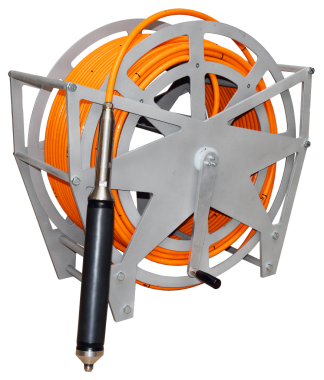DWS sparker for deep-towed high-resolution systems
The use of deep-towed high-resolution systems allows us to solve a number of problems that, due to physical limitations, cannot be implemented with near-surface equipment - one of these problems is the transition to the assessment of the elastic properties of bottom sediments.
Placing the receiving-emitting line below the target reflection time has a number of advantages over the traditional method and allows you to:
- Receive target reflections uncomplicated by interference with satellite waves.
- Significantly reduce the impact of towing noise on the recording.
- Increase the resolution of the laterals.
- Increase the range of angles of incidence for the boundary under study.
- To increase the bandwidth in the process.
- Go to the evaluation of the elastic properties of the medium.
In such studies, the forward wave pulse is not complicated by ghost-waves, which makes it possible to use it to control the quality of the excitation stability and evaluate the pulse shape for subsequent processing.
However, the implementation of a survey with a deep towed system is technically more complex than the classical surface collection method. Such work has not become widespread due to the difficulty of monitoring the exact position of the source and receiving line positions, as well as the complexity of data processing.
Realizing the important advantages of implementing deep surveys, we tried to solve a number of practical problems and offer a working industrial solution, including a deep-seated DWS sparker with replaceable electrode groups, special single-core load-bearing coaxial supply lines, depressors, pressure sensors, single-channel and multi-channel towed hydrophone streamers.
The DWS deep towed sparker is a sealed connector mounted on a single-core load-bearing coaxial cable with replaceable multi-electrode groups and a removable container for operation in fresh water. The frequency composition of the emitted signal increases with the deepening of the sparker due to an increase in hydrostatic pressure and a decrease in the life period (growth-collapse) of the vapor-gas cavity. In this regard, a relatively small number of electrodes in the radiating group is sufficient for operation – we offer replaceable attachment for 1, 10, 50 or 100 electrodes.
DWS sparkers are equipped with electrodes groups with an increased service life, which ensures a stable source signature at high energies per electrode, and also minimizes operational maintenance. Several models of easily replaceable groups allow you to achieve the desired pulse shape, and the design with minimal hydrodynamic resistance facilitates effective sinking.
The immersion of the receiving and radiating system to the required depth is provided by specialized depressors suspended on a load-bearing cable supply line, and the control of sinking is performed using optional pressure sensors that can be installed inside the seismic streamer and / or attached to the sparker.
We manufacture the sources of the required power and configuration. For the correct preparation of technical specifications for the purchase or rental of equipment, please contact us in any way specified on the website. The data processing capabilities can be found here.
|
|
DWS-1 |
DWS-10 |
DWS-50 |
DWS-100 |
|
Tips |
1 |
10 |
50 |
100 |
|
The recommended range of energies |
100 ÷ 1 250 J |
|||
|
Sound pressure level relative to 1 µPa at a distance of 1 m |
217 dB (at energy 3 J on the electrode) |
217 dB (at energy 3 J on the electrode) |
219 dB (at energy 3 J on the electrode) |
220 dB (at energy 3 J on the electrode) |
|
Pulse length* |
0.75 ÷ 2 ms |
|||
|
Frequency range* |
100 ÷ 8 000 Hz |
|||
|
Recommended MultiJack |
1250HP1.5 |
|||
|
Recommended coaxial supply line |
1×20 |
|||



